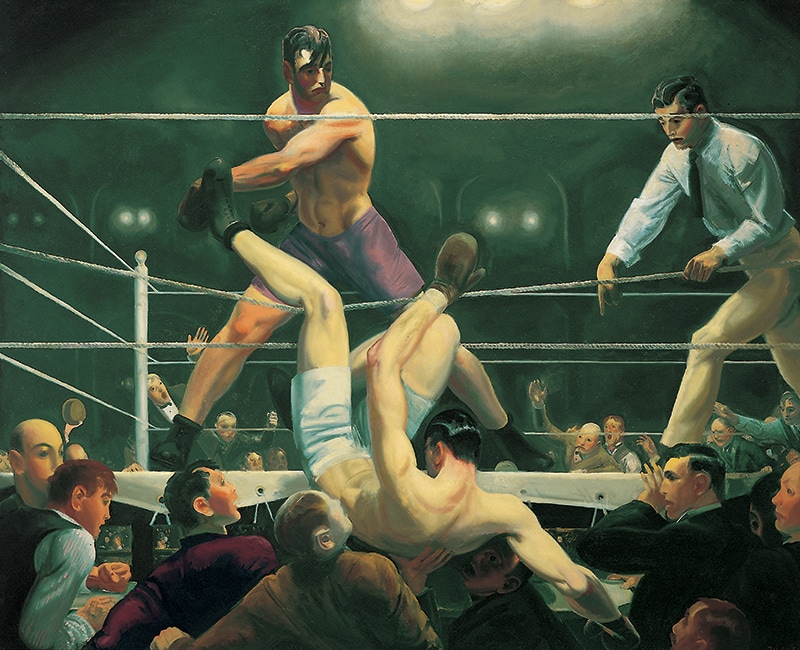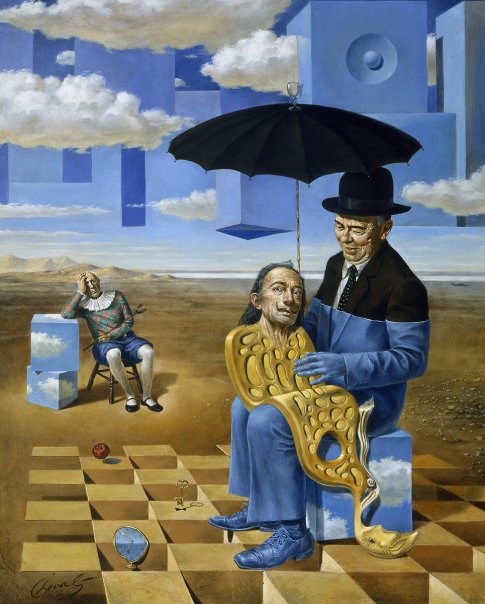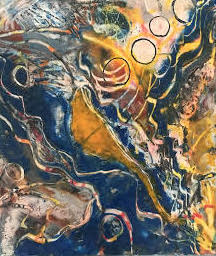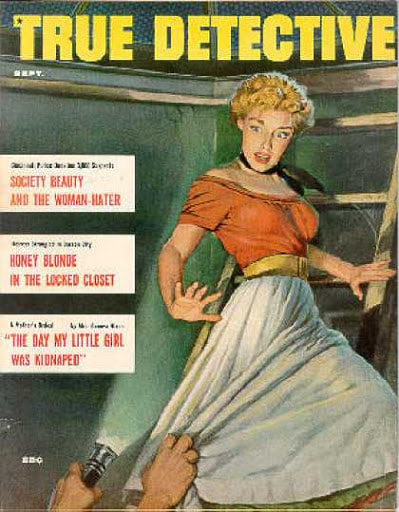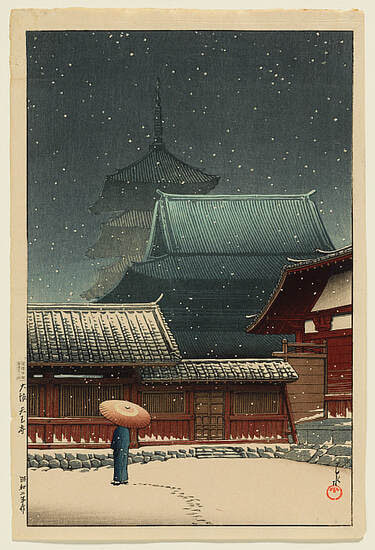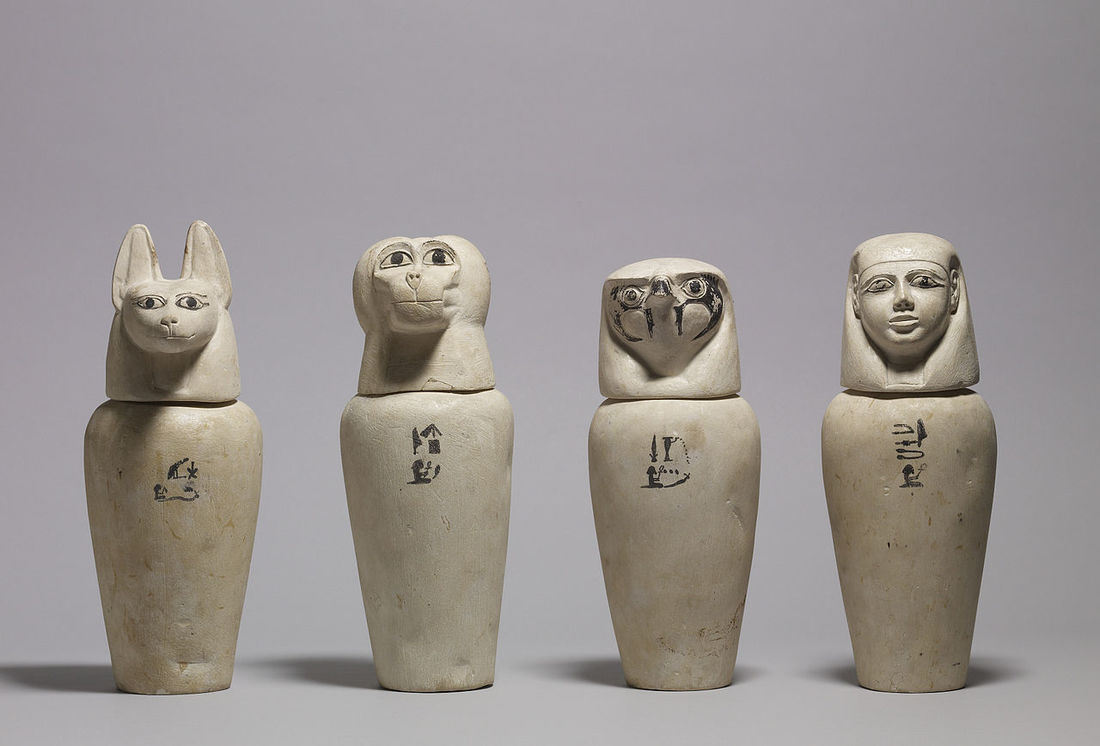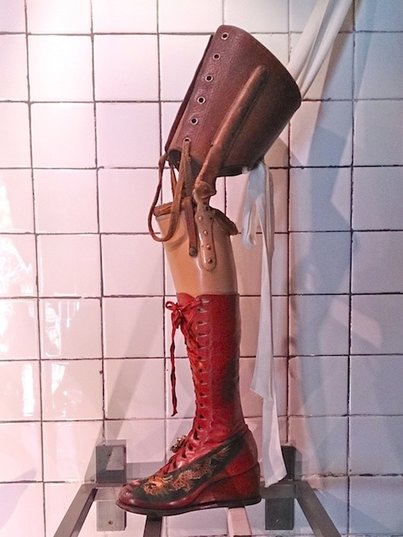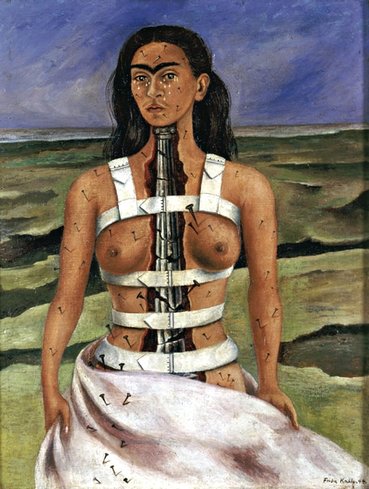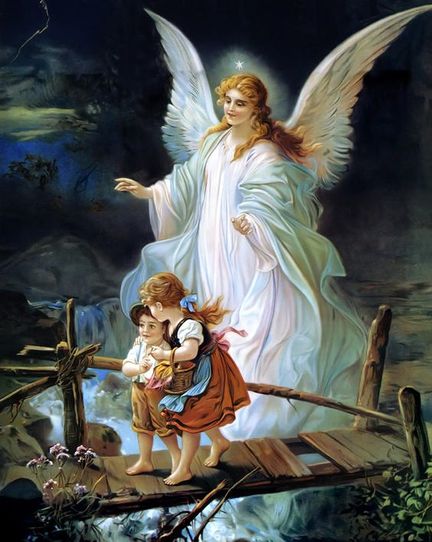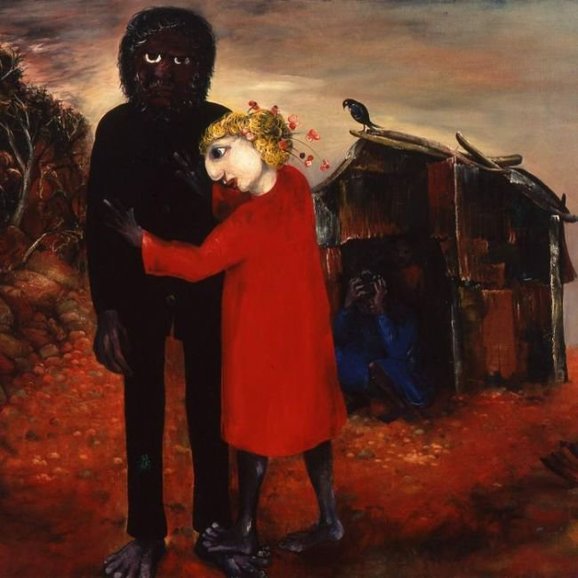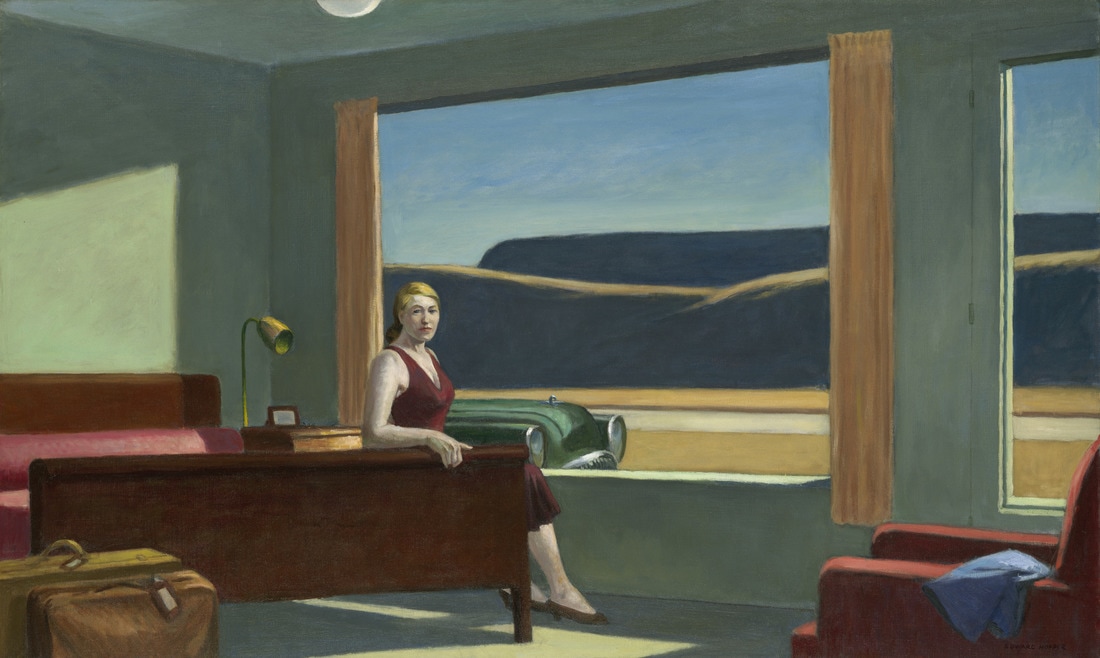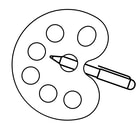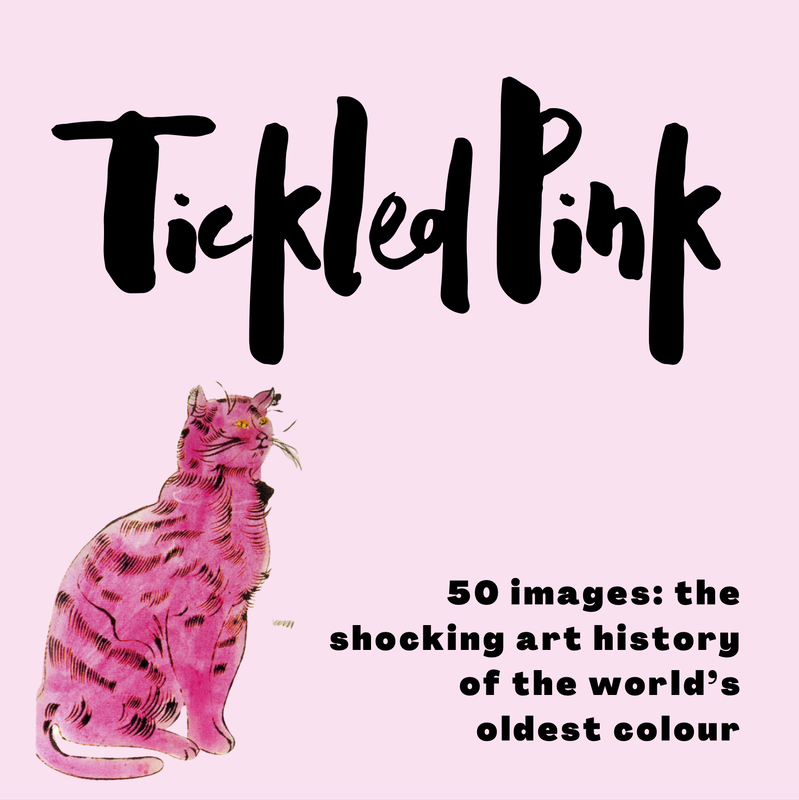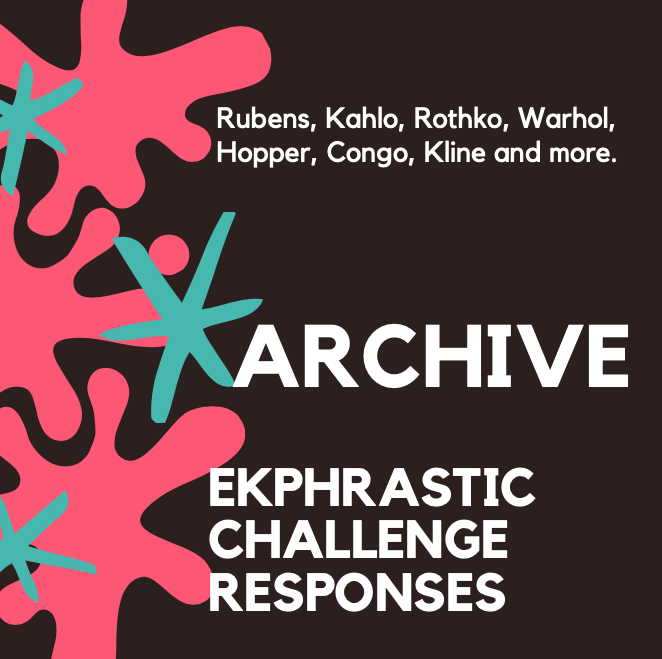|
One Minute Forty-Five of the First Round
[flash] [flash] [flash] and you’re [Sonny Liston] just punched down in [Ektachrome] color hit by the hardest man on Earth [flash] [flash] and he’s standing above you [daring you to get up] [flash] [flash] [flash] your [brain] has just been smashed against the wall of your skull [you can’t hear] [flash] [flash] your body is floating in seas of Africa and he’s daring you [“get up and fight sucker”] [flash] [flash] [flash] you can’t see the glowering white [mouthpiece] you have no legs [flash] [flash] but [maybe you’re the photographer] and you’ve stopped down the aperture [to deepen the focus] compositionally [Clay’s arm] forms a line that connects with [Liston’s raised knee] [Clay’s glove is raised] erect this is suffering you don’t want to get wrong [this is your dad talking now, “don’t screw it up”] so you open the lens to take in more of the ring and now it’s like a floating king-sized bed of pain but here comes the light [a sudden fleck of blood] then a single [bead of sweat] comes into focus through all the smoky dark and that’s the shot Henry Crawford Editor's Note: Henry Crawford's poem was a response to a famous 1965 photo by Neil Leifer called Ali-Liston (click here to view). Unfortunately the fees to show the image were not feasible, so we substituted another wonderful image, a painting by George Bellows. Thank you for clicking through to view the photograph on which the poem is based. Henry Crawford is a poet living and writing in the Washington, DC area. His work has appeared in several journals and online publications including Boulevard, Copper Nickel, Folio, Borderline Press and The Offbeat. He is a 2016 nominee for a Pushcart Prize for his poem “The City of Washington” appearing in District Lit. His first collection of poetry, American Software, is scheduled for publication in the Spring of 2017 by WordTech Communications through its imprint, CW Books.
0 Comments
Lullabye of Uncle Magritte
Salvador Dali never was a person at all. Overweening pride led a half-mad eccentric - also named Dali - to concoct a chimerical entity of a plastic head grafted upon a waffle iron torso. Dali then set out to convince the whole world that his creation was a human being of great artistic talent. The world soon grew bored of the Anthropomorphised Dali and forgot all about him. And that's how Rene Magritte, going for his daily constitutional, found the discarded remnants of the Dali Simulacrum melting under the hot hyperxiological sky, the golden metal endoskeleton grotesquely twisted and exposed. Taking pity upon the atavistic vestiges, Magritte placed them tenderly upon his lap, shielding the molten body with his umbrella and caring not that Dali's aristocratic blue blood permeated and stained his hands, suit and shoes. Pablo Picasso remained aloof, watching the scene from a distance, his arm resting upon cubes of sky he had carved off with his chisel. The geometrical sky looked on approvingly from above, happy in the knowledge that the events down on Earth mirrored the events in the celestial sphere. Boris Glikman Boris Glikman is a writer, poet and philosopher from Melbourne, Australia. The biggest influences on his writing are dreams, Kafka and Borges. His stories, poems and non-fiction articles have been published in various online and print publications, as well as being featured on national radio and other radio programs. Mountainsides I swaddled you in dreams from birth of health and happiness, of honeysuckle days and lightning bug nights, maybe someday Duke or Yale. For now, your frame too tiny, too frail for the massive canvas of colours that would paint your life. Cruising and crawling melted into days of dangling from paper-thin twigs on wintering trees. But by the first snowflake of your seventh year, your boots stood dry in your closet while you lay in bed for weeks drenched with fever. Illness . we did not understand robbed you of school days and playground games, biking, bowling, parties, and sleepovers with friends. Poking and prodding, tests and guesses were your life now, and finally treatment with promise of snowy boots next winter. Your sweet childhood was now your Everest, with every crag and crevice a boulder, every step an avalanche of fear, the distant peak poking through greying clouds like a beckoning finger, your damaged health a relentless, blustery thunderstorm. We didn't know the hardest part of climbing was never reaching the top. Not really. It was the sides. It was always the sides. Shelly Blankman Shelly Blankman and her husband Jon fill their empty nest in Columbia, Maryland with 4 cat rescues. They have two sons, one in New York and one in Texas. After a stint as a Graduate Teaching Assistant in the at Marshall University , she followed a career path in journalism and public relations, but her first love has always been poetry. She has been published previously in The Ekphrastic Review, as well as Visual Verse, Verse-Virtual, Silver Birch Press, Poetry Superhighway, and Praxis Magazine. Contents of a Canopic Jar (My Large Intestine Speaks)
Serqet clings tightly to her neck, and the girl turns mute but begins to breathe. Snake or scorpion, she is no match for my serpentine windings: five feet, home to a forgotten multitude of creatures, unevolved. Revolting, some think. Efflorescent population of a dark, moist microbiome that seems incidental, excremental. I am home to them all, and they break down the things you can never digest, like the falcon’s tomial tooth. That falcon-headed god said he’d return her heart. No matter, so long as my coils descend. Consume her, contain her. Emily Bowles Emily Bowles is a writer and teacher in Wisconsin. She's published poems in Page & Spine, The Road Not Taken, Word Curd, and the Wisconsin Fellowship of Poets' forthcoming calendar. Some of her writing is available on her blog at: http://braving77.blogspot.com/. Frida
On canvas skin, she tattoos herself, pulls down the zipper in the centre of her chest to show bone, rods of steel from the car accident, La Columna Rota a Calzada de Tlapan. Still life with bus ride and shrapnel, At The Pallacio de Bellas Artes, walls are full of blood, rinds of watermelon spilled of its seeds. 30,000 pieces of Frida behind glass X-rays of her fractured back, a ripped bus ticket, the ghost of my fingerprints on glass, a No Tocar, Do Not Touch in Spanish. They hang your blood on the wall, and we gawk, the heart unravelling, scissors in your hand to hold back the flow. Robert Walicki Robert Walicki's work has appeared in over 40 publications including Vox Populi, Stone Highway Review, The Kentucky Review, Red River Review, and others. A Pushcart and a Best of The Net nominee, Robert currently has two chapbooks published: A Room Full of Trees (Red Bird Chapbooks, 2014) and The Almost Sound of Snow Falling (Night Ballet Press), which was nominated to the 2016 Poet’s House List of Books in NYC. You Are Safe, Little Ones
I see a footbridge high above a gorge. One bannister is gone; the other lies on narrow rotting boards. Rough waters surge beneath this passageway that creaks and sighs in answer to footfalls of children who, while clinging to each other, move ahead with wary steps toward home and suppertime and hope they'll soon be safely tucked in bed. These innocents are not alone. Unknown to them, an angel stands close by to keep them safe from peril that could plunge them to the depths. Tonight no one will grieve and weep. Janice Canerdy Janice Canerdy is a retired high-school English teacher from Potts Camp, Mississippi. Her poems have appeared in various magazines, journals, and anthologies. Her first book, Expressions of Faith (Christian Faith Publishing, 2016), may be purchased online through Amazon and Barnes and Noble. *Editor's note: This famous painting of children crossing a bridge, protected by a guardian angel, is familiar to countless people whose childhood bedrooms included a print of the work, like a night light, or whose picture Bibles and Sunday Schools featured the art. There is much confusion over the artist, often listed as Lindberg Heilige Schutzengel, or sometimes as "Heilige Schutzengel by Lindberg." Heilige Schutzengel means Holy Guardian Angel in German, and is a reference to the content of the painting, but Linberg was one of the poster printers for this work, not the artist's name. H. Zabateri was an Austrian academic painter of mythological and religious scenes; however, he also did not exist and was a pseudonym for Hans Zatzka. In turn, Zatzka also used Pierre de Ronsard, Joseph Bernard, and Bernard Zatzka, adding to the tangle. The purpose behind the artist's multiple identities was probably, in part, eccentricity, but also pragmatic: he was extremely prolific, and contracts limited how many works he could legally sell, so one way to circumvent that was to paint under different names. Untitled
Sometimes visual artists represent difficult concepts in literal ways. Here, the painter represents mixed-racial parentage by painting Aboriginal extremities on a woman depicted as having a white face. The painting is from a series by Arthur Boyd titled Brides, which explores contemporary issues in marriage. Two worlds: mixed. Hands, feet choosing. Lindsey Thäden Lindsey Thäden is the most recent winner of New York's 2016 #PoetweetNYC contest. Her poetry has appeared or is forthcoming in the Philadelphia-based Apeiron Review, eleven40seven, New York Metro, Passages North and Vending Machine Press, which is e-published from Sydney, Australia. What about Courbet’s Origin of the World? What a place. What a face in the crowd. What theatre, so many entrances and exits. What an idyllic landscape, rolling hills and all that. What a place of worship. What an offense to good taste. What, a virgin? What about sex? What’s the title again? What about the scientist’s dilemma: like beginnings and endings, chickens and eggs? What great source material for a Bible study class. What about sex? What a serious discussion they had before she let Courbet set up shop between her legs. What I would have given to have been there. What happened in 1866 that inspired model and artist to create this work? What could have better sufficed to forward the confabulation of the times on absolutes? What is left to the imagination is far greater than what one supposes at first glance. What’s wrong in this picture? What’s not to like about it? What about sex? What about posing that question to the model? What we know is that some say her head was cut off and later found, others say not true. What is this painting doing here, displayed where so many innocents pass by every day? What a place of honor. What about sex? What a success. Jacalyn Carley Jacalyn Carley is a writer living in Berlin. She has published four books (only available in German translation), a number of poems and short fiction, and is currently dedicated to writing about and drawing the human figure. She is On-site Director for Sarah Lawrence College 'Summer Arts in Berlin' study abroad program. More about her: jacalyn-carley.com Somewhere in the West
Madge the Mysterious, what he called her when they met, waits stiff-backed in red dress on red bed in room with red chair. Viking bones could conquer his pasty freckled skin, towering insecurity about her towering height. Instead, she wears low heels, slouches beside him. She hopes he will admire her from the west-facing windows when he returns with another pack of cigarettes. He yelled last night. Because she needed a restroom? Because she turned the radio dial? They didn’t speak for miles. Didn’t speak even when he took her from behind in the night, then rolled over. He’s a good man, mostly, she had told her friend Lena. He just gets mad sometimes, over details. He likes order. Likes his way more like, Lena said, having seen blood flush his face on their double date when Madge ordered another drink. They walked behind the men after dinner. Madge whispered, I hate how he tastes after a smoke. She didn’t smoke but always kissed Hank back, not saying anything, not since a few weeks after they met. Wealthy, well-traveled Hank made her want to abandon her hometown, secretarial job, family, her life. Madge wants to be irresistible so Hank will take her farther in his peacock-proud green car. He said they’d see red-pink-beige mesas; mountains; canyons. But all she’s seen is miles of crop fields, crosses, red-white-blue flags, cattle, ranches, so many star symbols, barbed wire. She said, This isn’t what I thought the West would look like. Hank flicked the burned down Camel bud out his open window, the window that let wind in to whip her ash-blonde hair into her eyes. This ain’t the West yet, honey. She’d never been this far from Baltimore, thought, This must be the middle-west, or thereabouts, a godforsaken place of tornados raging, tossing, tearing, taking at whim. Hank talked nuptials but hadn’t proposed, had wandering eyes that glue-stuck on other women. Madge formulated the plan while he drove, while she pretended to sleep. She had money in her suitcase lining. She would leave where and when he least expects. Not Vegas or Hollywood. Not that far. Madge will disappear in some city with a bus or train to take her to a place that shows a shade of red she recognizes in herself; a place that cannot own her; a place that will save her life. Janet St. John Janet St. John lives and writes in New Mexico. Her poetry and flash fiction have appeared in numerous literary magazines includingThe Nebraska Review, Poet Lore, StepAway, After Hours, Snapdragon: A Journal of Art and Healing, Canary: A Literary Journal of Environmental Crisis,and bosque: the magazine. With arts funding under attack, she is dedicated to writing and creating even more art, keeping convos about the arts even more alive, and personally supporting as many artists and arts programs as she can. Her weekly blog series "Art & Soul Shorts" is part of that mission: https://www.janetstjohn.com/blog |
The Ekphrastic Review
COOKIES/PRIVACY
This site uses cookies to deliver your best navigation experience this time and next. Continuing here means you consent to cookies. Thank you. Join us on Facebook:
Tickled Pink Contest
April 2024
|
